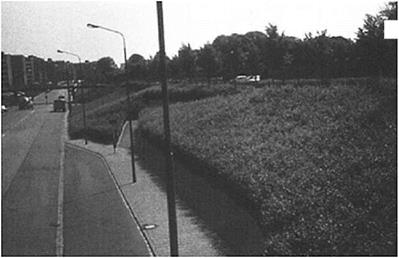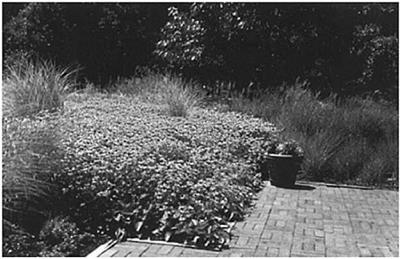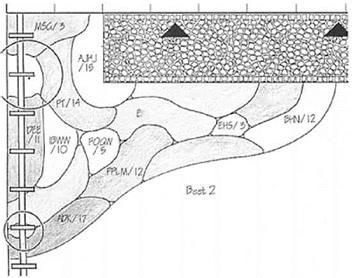Before moving on to discussing the specification and depiction of naturalistic plantings, we will first briefly mention the way that the grouping of plants in standard landscape and garden plantings are depicted. In order to do so, it is helpful to categorise such plans into three main types that form the basis of most standard approaches to producing planting plans: the monoculture, the block and the drift. These terms generally refer to layers of planting beneath tree level—shrub and herbaceous layers. Trees, being larger – scale units, are generally depicted
 |
9.1
Monocultural planting—ground – cover shrub mass
 |
9.2
The perennials and grasses in this scheme by the Oehme and Van
Sweden partnership are planted in large blocks
as individuals, unless planting is on a woodland scale. An excellent overview of the composition of planting plans for landscape and garden plantings is given in Robinson (1992). It is not the intention of this chapter to provide an in-depth guide to the drafting of a planting plan, but rather to indicate different approaches to setting out a planting and how these might be communicated graphically.
Monoculturalplantings (Figure 9.1) represent the antithesis of what much of this book is about, featuring extensive plantings of one or two species (usually cultivars), often filling up space alongside highways, in commercial developments or public landscapes. This type of planting is more commonly encountered on a large scale in continental Europe rather than Britain, and is essentially a modernist concept, treating planting in a purely functional sense, as ‘green concrete’. Aesthetically, there is a certain simplicity, purity and sense of scale about monocultural planting that works well in certain contexts and, of course, in terms of drawing up planting plans, very little basic knowledge is required (because the same small pool of plants are used ubiquitously) and it is time- efficient because of the lack of complexity.
Block planting is essentially a more complex version of the above and is perhaps the most common approach to landscape planting. Rather than using extensive areas of the same species, smaller monocultural blocks are arranged adjacent to each other to fill a space with planting (Figure 9.2). However, this remains a relatively simple approach to putting together a planting that again draws, in the main, from a limited plant palette. In the context of landscape planting, limited aesthetic decisions are made: perhaps plants will be graded according to height or foliage colour but, generally, plants are again treated as green materials—tough space-fillers. Block planting does result in textural variety and a degree of diversity, but the rigid demarcation of groups in regular shapes and the predominance of evergreens makes for visually dull and undemanding landscape.
Of the planting types described earlier in this book, the perennial and grass plantings of the Oehme and Van Sweden partnership (see Chapter 3) come closest to this approach, but the greater use of contrasting forms, the softer nature of perennials and a higher degree of seasonal change, lift these plantings beyond the mundane.
Drift planting could be regarded as an extension of block planting. Plants are still used in demarcated monocultural groups, but groups are much more intimately arranged, with a range of group sizes and shapes, and groups are generally arranged to give a direction to the planting. Drift planting (Figure 9.3) has very much grown out of the British informal garden planting tradition, and owes much to the design style of Gertrude Jekyll who employed


9.3
Ornamental drift planting—part of a scheme incorporating paving and a pergola (the plant names and quantities are not important). Plan by Gunther Rapp, HS Anhalt, Bernburg, Germany
нет
9.4
Drift planting—the natural model. Drifts and patches of buttercups in an agricultural field
colour-themed drifts of hardy and tender perennials arranged by height, with the main visual effect of the planting gained at an angle or along the length of the planting, rather than straight on, thereby increasing the sense of depth.
Drift planting was originally intended in the late 1800s to mirror the patterns of natural vegetation (Figure 9.4), giving a more naturalistic appearance than the more formal schemes common at the time, and also attempted to capture the effect of the somewhat chaotic vernacular cottage gardens that again were seen as an antidote to highly controlled geometric gardens
Despite being a century old, this style of planting remains the predominant style in British garden design, and the more studied of landscape schemes. The associations between plant groups are much more intimate in drift planting and, as a result, there is greater emphasis on both contrast and harmony in colour, form and texture between nearby plants.
Because drift planting has its roots in natural patterns, it is not surprising that strongly naturalistic schemes can be created using this technique, especially when free-growing or wild-character perennials are used. For example, Figure 9.5 shows spontaneous ruderal vegetation composed of interlocking strands of clonal perennials and grasses. A clear pattern of drifts and groups is apparent.



